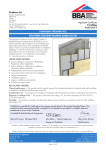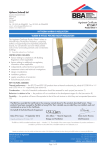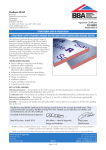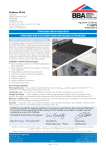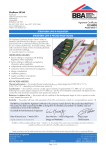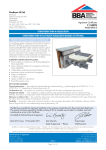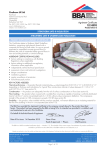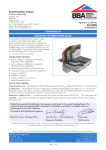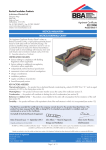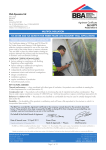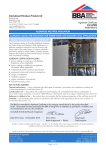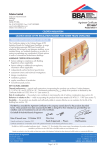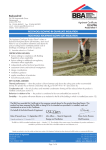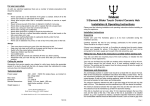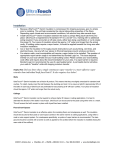Download Xtroliner XO/RS BBA Cert PDF
Transcript
Xtratherm Ltd APPROVAL INSPECTION TESTING CERTIFICATION Liscarton Industrial Estate Kells Road Navan Co Meath Ireland Tel: 00 353 46 906 6000 Fax: 00 353 46 906 6090 TECHNICAL APPROVALS FOR CONSTRUCTION Agrément Certificate 12/4956 e-mail: [email protected] website: www.xtratherm.com Product Sheet 5 XTRATHERM XTROLINER (XO) XTRATHERM XTROLINER RAINSCREEN BOARD (XO/RS) This Agrément Certificate Product Sheet (1) relates to Xtratherm XtroLiner Rainscreen Board (XO/RS) for use as thermal insulation either between internal studding and against the external face of the sheathing board/steel studs of walls of conventional timber-frame or steel-frame buildings, or over the external face of masonry walls. The product is for use on domestic and non-domestic buildings. (1) Hereinafter referred to as ‘Certificate’. CERTIFICATION INCLUDES: • factors relating to compliance with Building Regulations where applicable • factors relating to additional non-regulatory information where applicable • independently verified technical specification • assessment criteria and technical investigations • design considerations • installation guidance • regular surveillance of production • formal three-yearly review. KEY FACTORS ASSESSED Thermal performance — the product can be used to improve the thermal performance of external walls and contribute to meeting the Building Regulations (see section 6). Condensation risk — the product can contribute to limiting the risk of interstitial and surface condensation (see section 7). Behaviour in relation to fire — The product achieved the fire rating C-s2, d0 when classified to BS EN 13501-1 : 2007 (see section 8). Durability — the product is durable and sufficiently stable to remain effective as insulation for the life of the building (see section 12). The BBA has awarded this Certificate to the company named above for the product described herein. This product has been assessed by the BBA as being fit for its intended use provided it is installed, used and maintained as set out in this Certificate. On behalf of the British Board of Agrément Date of First issue: 28 August 2013 John Albon — Head of Approvals Claire Curtis-Thomas Energy and Ventilation Chief Executive The BBA is a UKAS accredited certification body — Number 113. The schedule of the current scope of accreditation for product certification is available in pdf format via the UKAS link on the BBA website at www.bbacerts.co.uk Readers are advised to check the validity and latest issue number of this Agrément Certificate by either referring to the BBA website or contacting the BBA direct. British Board of Agrément Bucknalls Lane Watford Herts WD25 9BA ©2013 Page 1 of 9 tel: 01923 665300 fax: 01923 665301 e-mail: [email protected] website: www.bbacerts.co.uk Regulations In the opinion of the BBA, Xtratherm XtroLiner Rainscreen Board (XO/RS), if installed, used and maintained in accordance with this Certificate, will meet or contribute to meeting the relevant requirements of the following Building Regulations (the presence of a UK map indicates that the subject is related to the Building Regulations in the region or regions of the UK depicted): The Building Regulations 2010 (England and Wales) (as amended) Requirement: B3 Internal fire spread (structure) Comment: A wall containing the product must incorporate cavity barriers and fire breaks as stipulated by this Requirement. See sections 8.1 and 8.2 of this Certificate. Requirement: C2(c) Resistance to moisture Comment: Requirement: L1(a)(i) Conservation of fuel and power Comment: Regulation: 7 Materials and workmanship Comment: Regulation: 26 CO2 emission rates for new buildings The product can contribute to satisfying this Requirement. See sections 7.1 and 7.4 of this Certificate. The product can contribute to a building meeting this Requirement. See section 6 of this Certificate. The product is acceptable. See section 12 and the Installation part of this Certificate. The product can contribute to satisfying this Regulation. See section 6 of this Certificate. Comment: The Building (Scotland) Regulations 2004 (as amended) Regulation: 8(1) Fitness and durability of materials and workmanship Comment: Regulation: Standard: 9 2.4 Building standards applicable to construction Cavities The product is acceptable. See section 12 and the Installation part of this Certificate. A wall containing the product must incorporate cavity barriers and fire breaks as stipulated by this Standard, with reference to clauses 2.4.1(1)(2) and 2.4.2(1)(2). See sections 8.1 and 8.2 of this Certificate. Comment: Standard: 3.15 Standard: Standard: 6.1(b) 6.2 7.1(a)(b) Statement of sustainability The product can contribute to meeting the relevant requirements of Regulation 9, Standards 1 to 6 and therefore will contribute to a construction meeting a bronze level of sustainability as defined in this Standard. In addition, the product can contribute to a construction meeting a higher level of sustainability as defined in this Standard, with reference to clauses 7.1.4(1)(2) [Aspects 1(1)(2) and 2(1)], 7.1.6(1)(2) [Aspects 1(1)(2) and 2(1)] and 7.1.7(1)(2) [Aspect 1(1)(2)]. See section 6.3 of this Certificate. Comment: Regulation: Carbon dioxide emissions Building insulation envelope The product can contribute to satisfying clauses, or parts of clauses, 6.1.6(1), 6.2.1(1)(2), 6.2.3(1), 6.2.4(2), 6.2.5(2), 6.2.9(1), 6.2.10(1), 6.2.11(1)(2), 6.2.12(2) and 6.2.13(1)(2) of these Standards. See section 6 of this Certificate. Comment: Standard: Condensation The product can contribute to satisfying this Standard, with reference to clauses 3.15.1(1)(2), 3.15.4(1)(2) and 3.15.5(1)(2). See sections 7.1 and 7.5 of this Certificate. Comment: 12 Building standards applicable to conversions Comments made in relation to this product under Regulation 9, Standards 1 to 6 also apply to this Regulation, with reference to clause 0.12.1(1) and Schedule 6(1). Comment: (1) Technical Handbook (Domestic). (2) Technical Handbook (Non-Domestic). The Building Regulations (Northern Ireland) 2012 Regulation: 23 Fitness of materials and workmanship Comment: Regulation: 29 Condensation Comment: Regulation: 35 Internal fire spread — Structure The product is acceptable. See section 12 and the Installation part of this Certificate. The product can contribute to satisfying this Regulation. See section 7.1 of this Certificate. A wall containing the product must incorporate cavity barriers and fire breaks as stipulated by this Regulation. See sections 8.1 and 8.2 of this Certificate. Comment: Regulation: Regulation: Comment: 39(a)(i) 40(2) Conservation measures Target carbon dioxide emission rate The product can contribute to a building meeting these Regulations. See section 6 of this Certificate. Construction (Design and Management) Regulations 2007 Construction (Design and Management) Regulations (Northern Ireland) 2007 In the opinion of the BBA, there is no information in this Certificate which relates to the obligations of the client, CDM co-ordinator, designer and contractors under these Regulations. Page 2 of 9 Additional Information NHBC Standards 2013 NHBC accepts the use of Xtratherm XtroLiner Rainscreen Board (XO/RS), provided it is installed, used and maintained in accordance with this Certificate, in relation to NHBC Standards, Chapter 6.2 External timber framed walls and Chapter 6.9 Curtain walling and cladding. Technical Specification 1 Description 1.1 Xtratherm XtroLiner Rainscreen Board (XO/RS) comprises rigid polyisocyanurate foam board, faced with a composite foil-facing on both sides, and is manufactured in accordance with BS EN 13165 : 2012. The board has the nominal characteristics shown in Table 1. Table 1 Nominal characteristics Length (mm) 2400 Width (mm) 1200 Thickness (mm) 25 to 120 in 5 mm increments Minimum compressive strength (kPa) 120 Declared tensile strength perpendicular to faces (kPa) 40 1.2 The board is fixed either between timber studding/steel studding and against the external face of the sheathing board/steel studs, or against the external face of masonry substrates, in conjunction with masonry or weathertight rainscreen cladding(1) (maintaining a cavity to ensure drainage, provided the cladding load and wind load transfer directly to timber/steel studs. (1) Rainscreen cladding systems are proprietary and utilise various mechanisms for attaching cladding panels to the wall structure. Sitework guidance should be sought from system manufacturers. 1.3 Ancillary items for use with this product, but outside the scope of this Certificate are: • rainscreen cladding • rainscreen cladding and insulation fasteners/fixings • vapour control layer (VCL) and plasterboard in accordance with BS EN 520 : 2004 • breather membrane. 2 Manufacture 2.1 Raw materials are injected onto the lower foil-facer on a conveyor belt. The exothermic reaction expands the foam, which then comes into contact with the upper foil-facer. An automated process cures the product and cuts it to the required size. 2.2 As part of the assessment and ongoing surveillance of product quality, the BBA has: • agreed with the manufacturer the quality control procedures and product testing to be undertaken • assessed and agreed the quality control operated over batches of incoming materials • monitored the production process and verified that it is in accordance with the documented process • evaluated the process for management of nonconformities • checked that equipment has been properly tested and calibrated • undertaken to carry out the above measures on a regular basis through a surveillance process, to verify that the specifications and quality control operated by the manufacturer are being maintained. 2.3 The management system of Xtratherm Ltd has been assessed and registered as meeting the requirements of BS EN ISO 9001 : 2008 by the Loss Prevention Certification Board (Certificate 851). 3 Delivery and site handling 3.1 The product is delivered to site in polythene shrink-wrapped packs containing a label bearing the manufacturer’s trade name, product description and BBA identification mark incorporating the number of this Certificate. 3.2 It is essential that the product is stored raised off the ground, inside or under cover, on a dry, level surface in a well-ventilated area. The product must be protected from rain, snow and prolonged exposure to sunlight. If the product has been become wet or is damaged, it must not be used. Nothing should be stored on top of the product. 3.3 The product must not be exposed to a naked flame or other ignition sources. The product must not be exposed to solvents or other chemicals. Page 3 of 9 Assessment and Technical Investigations The following is a summary of the assessment and technical investigations carried out on Xtratherm XtroLiner Rainscreen Board (XO/RS). Design Considerations 4 General 4.1 Xtratherm XtroLiner Rainscreen Board (XO/RS) is effective in reducing the U value (thermal transmittance) of external walls of timber-frame, steel-frame or masonry buildings. It is essential that such walls are designed and constructed to incorporate the normal precautions against moisture ingress. Where there is a risk of the insulation becoming wet, a suitable breather membrane must be provided for the outer face of the insulation. 4.2 Substrate constructions incorporating Xtratherm XtroLiner Rainscreen Board (XO/RS) to which the cladding is fixed must be structurally sound and should be designed in accordance with the national Building Regulations. 4.3 The air gap between the face of the insulation and the back of the rainscreen panels should be of sufficient width to allow any water passing the joints to run down the back of the rainscreen panels and be discharged externally without wetting the insulation or the backing wall. The minimum width for air gaps required by NHBC is: • 50 mm for panels with open joints • 38 mm for panels with baffled or labyrinth (rebated) joints. 4.4 Care must also be taken in the overall design and construction of elements incorporating the products to ensure appropriate: • sheathing or bracing for frame elements. The product must not be relied on to provide any structural contribution, eg racking strength • fire resistance, for both elements and junctions • cavity barriers, fire dampers and non-combustible fire fixings • continuity of insulation to minimise thermal bridging • resistance to the ingress of precipitation and moisture from the ground. The product must not be used in situations where it bridges the damp proof course (dpc) in walls. 4.5 Care must be taken to ensure that the types of façade wall finishes and the detailing around openings are appropriate for the anticipated exposure conditions. 4.6 To resist the passage of moisture from the ground, adequate damp-proof courses (dpc’s) and damp-proof membranes (dpm’s) must be provided in accordance with conventional practice and BS 8215 : 1991. 4.7 Installation should not be carried out until the moisture content of the timber frame (where applicable) is less than 20%. 4.8 Installation of plasterboard must be in accordance with the relevant sections of BS 8212 : 1995. 5 Practicability of installation The product is designed to be installed by a competent general builder, or a contractor, experienced with this type of product. 6 Thermal performance 0.03. 6.1 Calculations of the thermal transmittance (U value) of specific external wall constructions should be carried out in accordance with BS EN ISO 6946 : 2007, BRE Report BR 443 : 2006 and BRE Digest 465 : 2002 using the thermal conductivity (D) value of 0.021 W·m–1·K–1 for the product and a foil surface emissivity () of 6.2 The U value of a completed wall construction will depend on the insulation thickness, number and type of fixings, the insulating value of the substrate and its internal finish. 6.3 When considering insulation requirements, designers should refer to the detailed guidance contained in the documents supporting the national Building Regulations. The U values shown in Table 2 indicate that the product can contribute to a wall achieving the typical design U values referred to in those supporting documents. Page 4 of 9 Table 2 Example U values (1) Insulation thickness (mm) installed against the sheathing board Insulation thickness (mm) between 140 mm deep timber studs (2) Insulation thickness (mm) between 90 mm deep steel studs(3) U value (W·m–2·K–1) 120 90 — 0.11 120 — 90 0.12 50 70 — 0.17 50 — 70 0.21 (1) Construction (external to internal) comprises: • Insulation against 9 mm thick OSB sheathing for the timber frame construction ( = 0.13 W·m–1·K–1) or 9 mm thick magnesium silicate board for the steel frame construction ( = 0.090 W·m–1·K–1) • 15% timber fraction for timber frame or 0.4% steel fraction for steel frame (with 44 mm flanges). Remaining space will be a low emissivity cavity • 15 mm thick plasterboard ( = 0.25 W·m–1·K–1). (2) Calculations based upon 5.2 galvanized steel fixings per metre square (8.8 mm2 cross sectional area, = 50 W·m–1·K–1). (3) Calculations based upon 2.8 galvanized steel fixings per metre square (15.9 mm2 cross sectional area, = 50 W·m–1·K–1). 6.4 The product can contribute to maintaining continuity of thermal insulation at junctions between elements. For Accredited Construction Details the corresponding psi values in BRE Information Paper IP 1/06, Table 3, may be used in carbon emission calculations in Scotland and Northern Ireland. Detailed guidance for other junctions, and on limiting heat loss by air infiltration, can be found in: England and Wales — Approved Documents to Part L and for new thermal elements to existing buildings, Accredited Construction Details (version 1.0). See also SAP 2009 Appendix K and the iSBEM User Manual for new-build Scotland — Accredited Construction Details (Scotland) Northern Ireland — Accredited Construction Details (version 1.0). 7 Condensation risk Interstitial condensation 7.1 Walls incorporating the product will limit the risk of interstitial condensation adequately when they are designed and constructed in accordance with BS 5250 : 2011, Annexes D and G. A VCL should be used in steel and timber constructions. 7.2 For the purposes of assessing the risk of interstitial condensation, the insulation core vapour resistivity may be taken as approximately 300 MN·s·g–1·m–1, and a resistance value of 7000 MN·s·g–1 for each individual foil-facing. 7.3 The joints between the Xtratherm XtroLiner Rainscreen Board (XO/RS), when used against the external face of the sheathing board/steel studs, must not be taped. If the product is to be used in the external walls of rooms expected to have high humidity, care must be taken to provide adequate permanent ventilation to avoid possible problems from the formation of interstitial condensation in the wall. Surface condensation 7.4 Walls will limit the risk of surface condensation adequately when the thermal transmittance (U value) does not exceed 0.7 W·m–2·K–1 at any point and the junctions with floors, roofs and openings are designed in accordance with Limiting thermal bridging and air leakage : Robust construction details for dwellings and similar buildings TSO 2002, BRE Information Paper IP 1/06 or section 6.4 of this Certificate. 7.5 For buildings in Scotland, constructions will be acceptable where the thermal transmittance (U value) of the wall does not exceed 1.2 W·m–2·K–1 at any point and openings and junctions with other elements comply with the guidance given in Annex G of BS 5250 : 2011 or section 6.4 of this Certificate. Additional guidance can be found in BRE Report BR 262 : 2002. 8 Behaviour in relation to fire 8.1 The product achieved the fire rating C-s2, d0 when classified to BS EN 13501-1 : 2007. 8.2 Constructions utilising the insulation will incorporate cavities. As the insulation is combustible, cavity barriers and fire breaks should be used where required by the relevant Building Regulations. A minimum of one stainless steel anchor per square metre must be installed, in accordance with the design principles given in BRE Report BR 135 : 2003. 8.3 Timber- and steel-framed systems using Xtratherm XtroLiner Rainscreen Board (XO/RS) product were tested for fire-resistance in accordance with BS EN 1365-1 : 1999 on load bearing constructions. Test results indicated that certain wall constructions can achieve fire resistance ratings up to 30 minutes or 60 minutes, measured against the loadbearing capacity, integrity and insulation criteria of BS EN 1365-1 : 1999. The tested timber and steel framed systems are outside the scope of this Certificate — system details are available from the Certificate holder. Page 5 of 9 9 Strength and stability 9.1 The wall and sub-frame to which the product is fixed and installed between should be structurally sound and constructed in accordance with section 4.2; however, when designing the wall for strength, stability and racking, no contribution from the insulation should be assumed. 9.2 The product is capable of transmitting its self-weight to the structure. The adequacy of fixing to the structural frame or substrate for specific installations is outside the scope of this Certificate and must be verified by a suitably qualified and experienced individual. 9.3 This individual must ensure the Xtratherm XtroLiner Rainscreen Board (XO/RS) product’s physical properties are sufficient to resist secondary wind loads resulting from open jointed cladding systems (see Table 3). Table 3 Physical properties Declared tensile strength perpendicular to faces (kPa) Minimum compressive strength at 10% compression (kPa) Characteristic bending strength (kPa) (1) 40 120 1024 (1) Specimen tested with dimensions of 175 mm by 150 mm by 25 mm. 10 Proximity of flues and appliances When installing the product in close proximity to certain flue pipes and/or heat-producing appliances, the following provisions of the national Building Regulations are applicable: England and Wales — Approved Document J, sections 1 to 4 Scotland — Mandatory Standard 3.19, clauses 3.19.1(1)(2) to 3.19.9(1)(2) (1) Technical Handbook (Domestic). (2) Technical Handbook (Non-Domestic). Northern Ireland — Technical Booklet L, sections 2 to 5. 11 Maintenance As the product is confined behind the wall lining and has suitable durability (see section 12), maintenance is not required. 12 Durability The product will have a life equivalent to that of the wall structure in which it is incorporated. Installation 13 General 13.1 Installation of the product should be in accordance with the Certificate holder’s instructions and current good building practice. 13.2 The product is light to handle and can be cut easily but care must be taken to prevent damage, particularly at edges. 13.3 It is important to that the product is accurately trimmed in order to achieve close butting joints and continuity of insulation. 14 Procedure Masonry walls 14.1 The product is installed, fully restrained against the wall in a brick bond pattern with suitable proprietary insulation fasteners (see Figure 1). Page 6 of 9 Figure 1 Example installation Between studs and on the external face of sheathing/studs — external to internal 14.2 The Xtratherm XtroLiner Rainscreen Board (XO/RS) is fixed to the outside of the sheathing board (when installed) or to the outside face of steel studs using suitable proprietary insulation fasteners. 14.3 The product is closely butted and joints are staggered. The outer face of the product must not be taped. 14.4 The product should be cut to fit tightly between the timber studding/steel studding and positioned against the inner face of the sheathing board or level with the external face of steel studs. Any gaps should be filled with expanding insulation foam (outside of the scope of this Certificate). In timber frame constructions, the product should be held in place by nails or timber battens to the warm side of the insulation. 14.5 The void created by the space between the inner surface of the product and the dry lining can be utilised as an insulated service duct. It is recommended that services which penetrate the VCL, such as light switches and power outlets, are kept to a minimum to limit damage to the VCL. In addition, any penetrations should be adequately sealed to preserve the VCL integrity. 14.6 A sealed polythene VCL with lapped and sealed joints is placed over the stud face before applying the internal finish. Technical Investigations 15 Tests Tests were carried out on Xtratherm XtroLiner Rainscreen Board (XO/RS) by the BBA in accordance with BS EN 13165 : 2012 to determine: • dimensional stability • compressive strength • thermal conductivity • tensile strength • bending strength. 16 Investigations 16.1 An assessment was made of the results of test data to BS EN 13165 : 2012 in relation to: • dimensions • value. 16.2 An assessment of the risk of interstitial condensation was made. 16.3 An assessment was made of typical constructions which achieve the design U values. 16.4 The manufacturing process was examined, including the methods adopted for quality control, and details were obtained of the quality and composition of the materials used. Page 7 of 9 Bibliography BS 5250 : 2011 Code of practice for control of condensation in buildings BS 8212 : 1995 Code of practice for dry lining and partitioning using gypsum plasterboard BS 8215 : 1991 Code of practice for design and installation of damp-proof courses in masonry construction BS EN 520 : 2004 Gypsum plasterboards — Definitions, requirements and test methods BS EN 1365-1 : 1999 Fire resistance tests for loadbearing elements — Walls BS EN 13165 : 2012 Thermal insulation products for buildings — Factory made rigid polyurethane foam (PUR) products — Specification BS EN 13501-1 : 2007 Fire classification of construction products and building elements — Classification using test data from reaction to fire tests BS EN ISO 6946 : 2007 Building components and building elements — Thermal resistance and thermal transmittance — Calculation method BS EN ISO 9001 : 2008 Quality management systems — Requirements BRE Digest 465 : 2002 U-values for light steel-frame construction BRE Information Paper IP 1/06 Assessing the effects of thermal bridging at junctions and around openings BRE Report BR 135 : 2003 Fire Performance of External Insulation for Walls of Multi-Storey Buildings BRE Report BR 262 : 2002 Thermal insulation: avoiding risks BRE Report BR 443 : 2006 Conventions for U-value calculations Page 8 of 9 Conditions of Certification 17 Conditions 17.1 This Certificate: • relates only to the product/system that is named and described on the front page • is issued only to the company, firm, organisation or person named on the front page — no other company, firm, organisation or person may hold or claim that this Certificate has been issued to them • is valid only within the UK • has to be read, considered and used as a whole document — it may be misleading and will be incomplete to be selective • is copyright of the BBA • is subject to English Law. 17.2 Publications, documents, specifications, legislation, regulations, standards and the like referenced in this Certificate are those that were current and/or deemed relevant by the BBA at the date of issue or reissue of this Certificate. 17.3 This Certificate will remain valid for an unlimited period provided that the product/system and its manufacture and/or fabrication, including all related and relevant parts and processes thereof: • are maintained at or above the levels which have been assessed and found to be satisfactory by the BBA • continue to be checked as and when deemed appropriate by the BBA under arrangements that it will determine • are reviewed by the BBA as and when it considers appropriate. 17.4 The BBA has used due skill, care and diligence in preparing this Certificate, but no warranty is provided. 17.5 In issuing this Certificate, the BBA is not responsible and is excluded from any liability to any company, firm, organisation or person, for any matters arising directly or indirectly from: • the presence or absence of any patent, intellectual property or similar rights subsisting in the product/system or any other product/system • the right of the Certificate holder to manufacture, supply, install, maintain or market the product/system • actual installations of the product/system, including their nature, design, methods, performance, workmanship and maintenance • any works and constructions in which the product/system is installed, including their nature, design, methods, performance, workmanship and maintenance • any loss or damage, including personal injury, howsoever caused by the product/system, including its manufacture, supply, installation, use, maintenance and removal • any claims by the manufacturer relating to CE marking. 17.6 Any information relating to the manufacture, supply, installation, use, maintenance and removal of this product/ system which is contained or referred to in this Certificate is the minimum required to be met when the product/system is manufactured, supplied, installed, used, maintained and removed. It does not purport in any way to restate the requirements of the Health and Safety at Work etc. Act 1974, or of any other statutory, common law or other duty which may exist at the date of issue or reissue of this Certificate; nor is conformity with such information to be taken as satisfying the requirements of the 1974 Act or of any statutory, common law or other duty of care. British Board of Agrément Bucknalls Lane Watford Herts WD25 9BA ©2013 Page 9 of 9 tel: 01923 665300 fax: 01923 665301 e-mail: [email protected] website: www.bbacerts.co.uk









